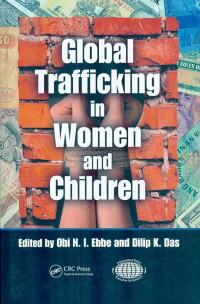
Text
Global trafficking in women and children
War, poverty, and famine; political, social, and economic change; and the deep seated views and rituals rooted in a culture’s history and traditions all contribute to the widespread and growing trafficking of women and children. The multilayered complexity, myriad contributing factors, enormous amount of money involved, and sheer magnitude of the problem render it impossible to solve with the fractured and isolated measures of individual organizations and countries. Only complete cooperation and collaboration at all levels can establish the most proactive and self-sustaining approach to reduce this global crime. Gathering knowledge and experience from more than 40 countries, Global Trafficking in Women and Children clearly demonstrates the scale and spread of the problem, providing a powerful analysis of the circumstances that contribute to the abuse and victimization of women and children as well as the international policies and strategies used to combat this crime. Divided into two parts, the book begins with an introduction to the definition, nature, and scope of human trafficking. It discusses several social theories as well as evident environmental influences. It also examines measures to control and prevent human trafficking from stricter laws and monetary aid, to global community and law enforcement collaboration. Part 2 consists of case studies, drawing examples from a range of countries involved in every stage in the process, and highlighting the unique characteristics of human trafficking in each. Chapters include the prevalence of child pornography in Japan, child abduction in China, bonded child labor in India, and child soldiering in Congo (Zaire) and other African countries. The final chapters discuss law enforcement in the US and UK, community policing in Australia, and the cooperative national plan in place in Croatia.
Availability
| KP.IV.3.00051 | KP.IV.3 EBB g | My Library | Available |
Detail Information
- Series Title
-
-
- Call Number
-
KP.IV.3 EBBE g
- Publisher
- Amerika Serikat : CRC Press., 2008
- Collation
-
xix, 251 hlm. ; 21 cm.
- Language
-
English
- ISBN/ISSN
-
978-1-4200-5943-4
- Classification
-
KP.IV.3
- Content Type
-
-
- Media Type
-
-
- Carrier Type
-
-
- Edition
-
-
- Subject(s)
- Specific Detail Info
-
-
- Statement of Responsibility
-
-
Other version/related
No other version available
File Attachment
Comments
You must be logged in to post a comment
 Computer Science, Information & General Works
Computer Science, Information & General Works  Philosophy & Psychology
Philosophy & Psychology  Religion
Religion  Social Sciences
Social Sciences  Language
Language  Pure Science
Pure Science  Applied Sciences
Applied Sciences  Art & Recreation
Art & Recreation  Literature
Literature  History & Geography
History & Geography